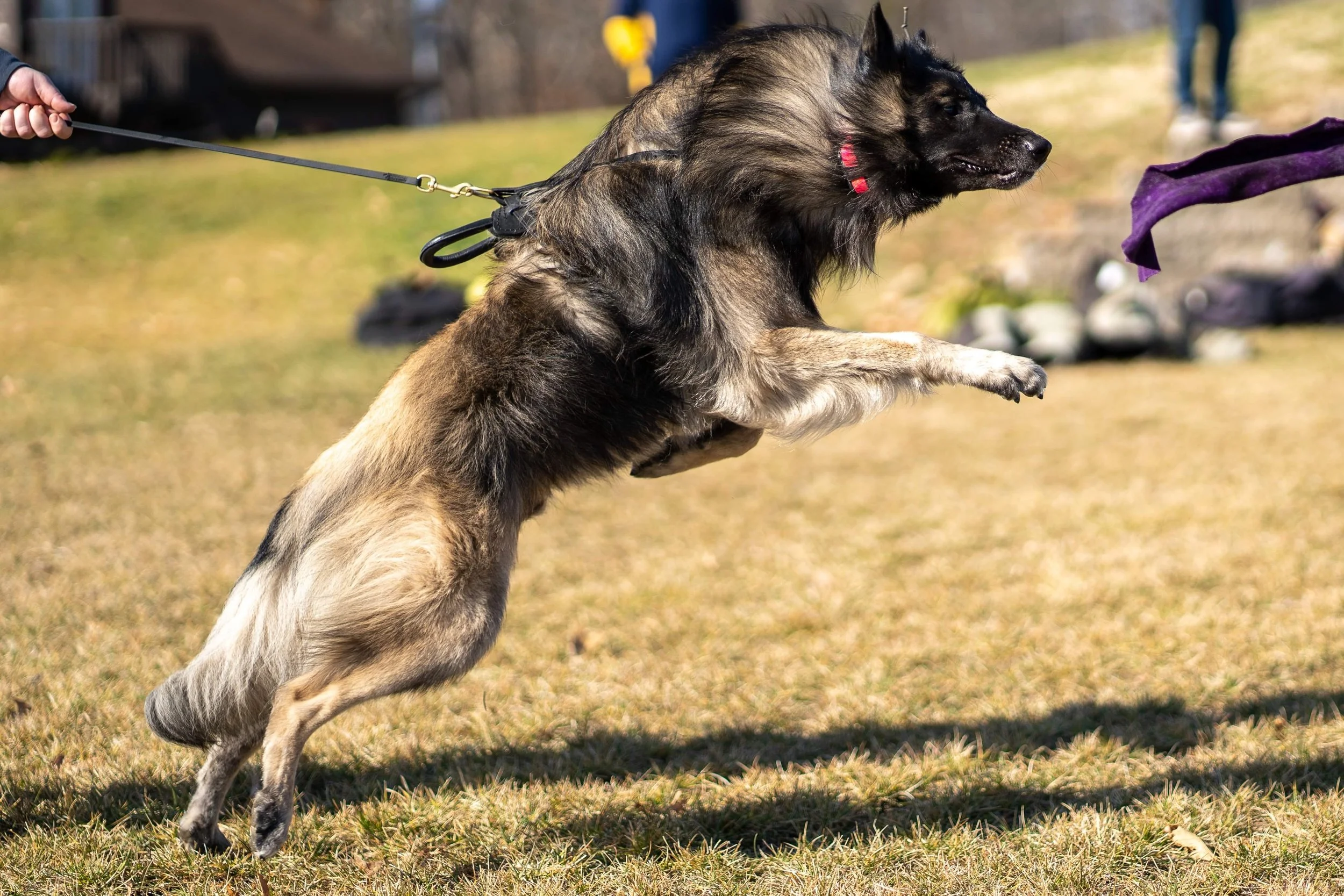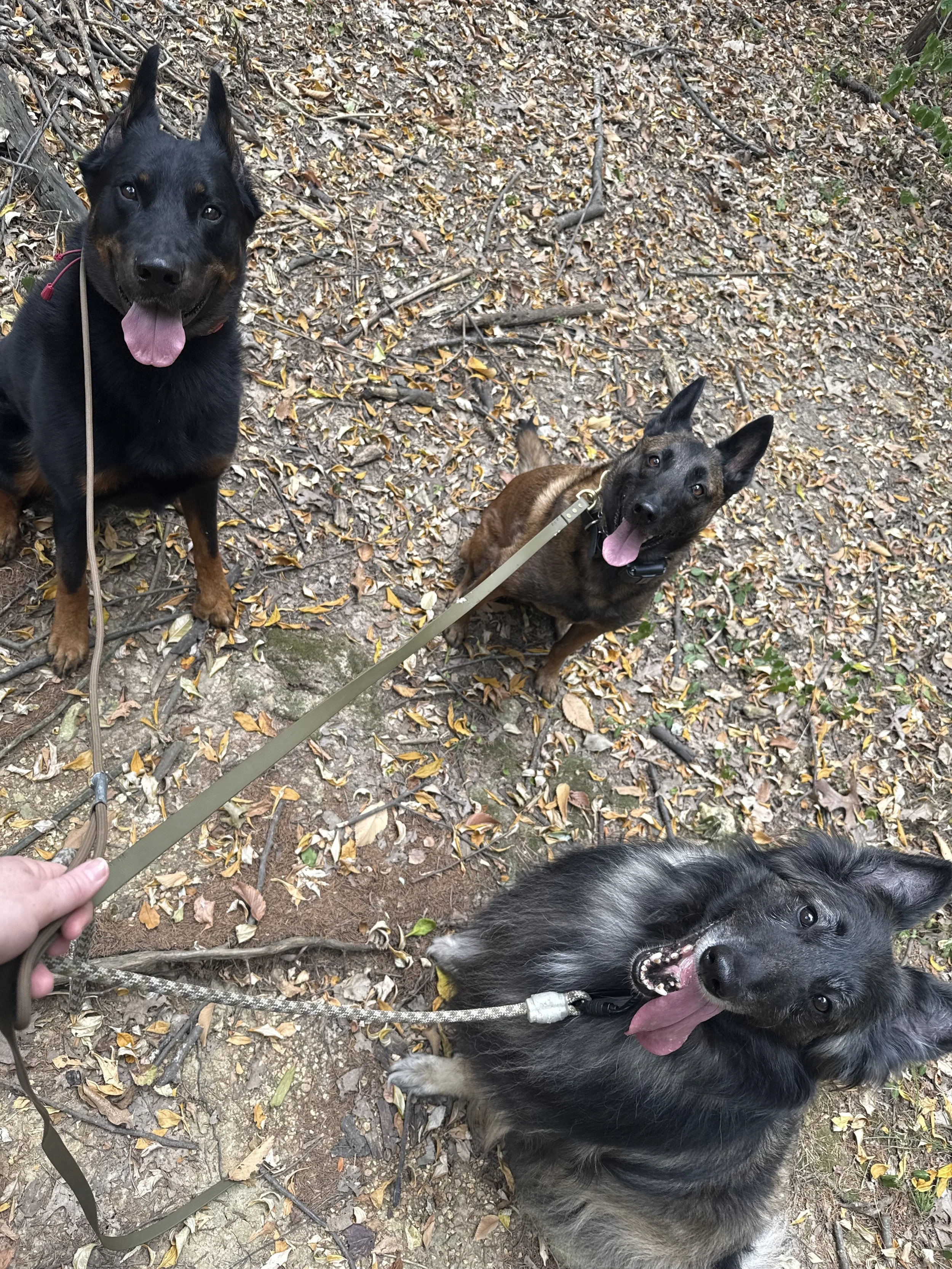🐾 Walking Your Dog: Why a Harness Might Not Be the Fix You Think
Walking your dog on a harness may seem like the best solution to all your pulling woes. After all, the sign in the pet store promised it would help. You see harnesses on dogs in photos, on social media, and out on hikes every day. From our human perspective, it makes perfect sense to assume that a harness is the key to peaceful walks.
But what’s really going on beneath all those sunshine-and-rainbows marketing promises?
Let’s pull back the curtain a bit and talk about why a harness might not be the best starting point when teaching your dog how to walk politely on leash — and how understanding your dog’s anatomy and natural instincts can completely change the walking experience for both of you.
This dog demonstrates how a harness helps him throw himself into the action of pulling. Here, we were utilizing building frustration with a harness to build drive to bite the leather rag.
Understanding the Opposition Reflex
Dogs, much like us, have a natural opposition reflex. It’s a built-in balancing mechanism. Imagine someone gently leaning into you or giving you a little push — your body automatically leans the opposite way so you don’t fall over. You don’t think about it; it’s instinct.
Dogs have that same reflex. When they feel pressure — whether it’s a hand, a leash, or body restraint — they instinctively push or pull into it. This reflex helps them stay balanced and grounded, but it also means that when your dog feels pressure from a leash or harness, their body naturally wants to move against it.
That means if your dog feels their harness tighten, their instinct is to lean forward and pull harder. It’s not defiance or stubbornness — it’s biology.
Why Harnesses Were Invented in the First Place
To understand why this matters, it helps to look back at history. Harnesses were originally designed by ancient civilizations to help animals pull heavy loads — think carts, plows, and sleds. These designs evolved to make pulling comfortable and efficient.
Traditional styles — such as yoke harnesses, chest-bar harnesses, and Y-shaped harnesses — all serve one purpose: to let the animal use the full power of their body without restriction. By distributing weight across the chest and shoulders, these harnesses allowed dogs and horses to throw themselves into the action of pulling safely and effectively.
And that’s exactly what a harness still does today. It allows your dog to pull — comfortably, powerfully, and for a long time.
So while harnesses are brilliant pieces of engineering for working dogs, they can be counterproductive for the average pet owner trying to teach loose-leash walking.
The Hidden Drawback of “No-Pull” Harnesses
Many modern harnesses are marketed as “no-pull” solutions. They often feature front clips or tightening straps that claim to discourage pulling. But here’s the catch: if the underlying leash communication isn’t trained, the harness isn’t really solving the problem — it’s just managing it temporarily.
Because a harness removes direct feedback from the leash, the dog doesn’t get a clear understanding of what the leash pressure means. Instead of learning to give in to light tension and follow the handler’s lead, the dog learns that they can still lean into the equipment and move forward.
The result? A dog that can pull harder for longer — and a human who’s getting increasingly frustrated on the other end. Over time, that frustration can spill into tension on the leash, making walks stressful for both of you.
Why Pulling Becomes Such a Problem
Pulling isn’t just inconvenient — it can also be dangerous.
For the dog, constant tension on the leash can cause overarousal, frustration, or even muscle strain. For the owner, it can mean sore shoulders, loss of control in busy areas, and a growing feeling that walks are more of a chore than a joy.
In highly stimulating environments — like busy streets, parks full of wildlife, or even your own neighborhood — this becomes even more challenging. Every scent, sound, and movement competes for your dog’s attention, and without a clear communication system in place, the leash quickly becomes a tug-of-war rope instead of a guide.
So, What Do We Do Instead?
At The Cordial Canine, we believe in starting simple and teaching communication first. That’s why we begin every dog’s leash education on a slip lead that can be safely locked into place.
When fitted correctly, the slip lead sits high on the neck, just behind the ears and under the jaw — an area where the opposition reflex is weakest. This positioning protects the trachea while allowing for clear, gentle feedback. If the dog pulls, they feel light pressure; when they release the tension, the leash relaxes immediately.
That release moment is gold. It gives us the perfect opportunity to mark and reward the correct behavior — the dog walking calmly by our side, choosing connection over pulling. Over time, the dog learns that a loose leash feels good and earns rewards, while pulling gets them nowhere.
The goal isn’t to rely on the slip lead forever. It’s to build understanding and communication first, so the dog can eventually walk politely on any equipment — whether that’s a flat collar, a harness, or even off-leash.
When Harnesses Do Have Their Place
Harnesses aren’t bad tools. In fact, once your dog understands leash manners, a well-fitted, Y-shaped harness can be a wonderful option for certain situations — like hiking, jogging, or any activity where you want extra security and comfort.
The key is using them after your dog has learned how to walk politely and respond to leash pressure. At that point, a harness becomes a comfort and safety tool — not a training crutch.
Final Thoughts
It’s easy to get swept up in the endless options of dog walking gear. Marketing tells us that the right harness, collar, or leash will solve all our problems — but equipment alone can’t teach your dog how to walk calmly. Only training and communication can do that.
At The Cordial Canine, our mission is to help both ends of the leash learn together. We teach dogs to understand leash pressure, focus, and relaxation, and we teach owners how to guide their dogs with clarity and kindness.
So try not to fall for the “dog gear gimmicks.” Instead, invest your energy in training and connection first.
Once your dog understands what you’re asking, the equipment you choose becomes just a tool — not a struggle.
Because when both ends of the leash are communicating clearly, every walk becomes what it should be: calm, connected, and truly enjoyable.



